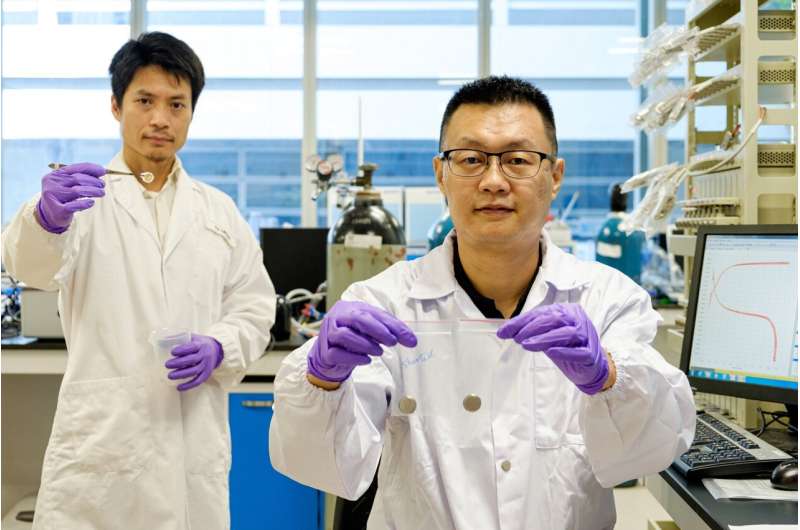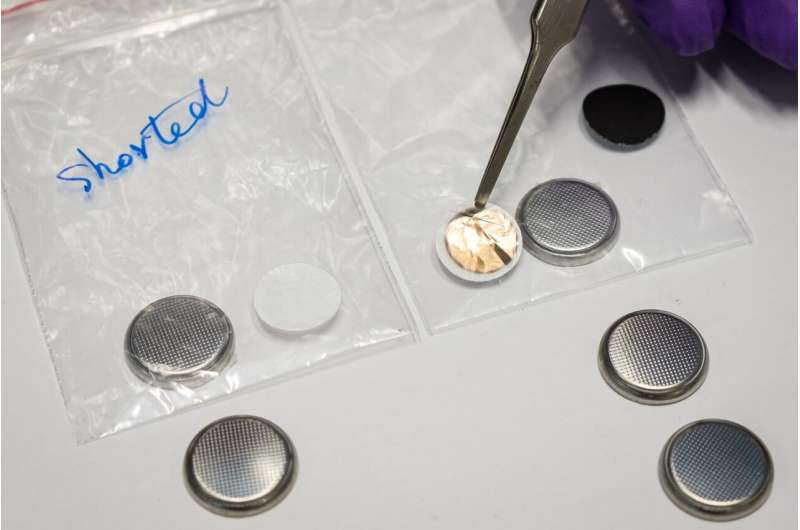A new technology that can prevent Li-ion battery fires

Materials scientists from Nanyang Technological University, Singapore (NTU Singapore) have found a way to prevent internal short-circuits, the main cause of fires in lithium (Li)-ion batteries.
Billions of Li-ion batteries are produced annually for use in mobile phones, laptops, personal mobile devices, and the huge battery packs of electric vehicles and aircraft.
This global battery demand is set to grow, with electric vehicles alone requiring up to 2,700 GWh worth of Li-ion batteries a year by 2030, equivalent to some 225 billion mobile phone batteries.
Even with an estimated failure rate of less than one-in-a-million, in 2020 there were 26 power-assisted bicycle fires and 42 cases of personal mobility device fires in Singapore.
In most Li-ion battery fires, the cause is due to a build-up of lithium deposits known as dendrites (tiny wire-like tendrils) that cross the separator between the positive (cathode) and negative (anode) electrodes of the battery when it is being charged, causing a short-circuit leading to an uncontrolled chemical fire.
To prevent this short-circuit from happening, Professor Xu Zhichuan and his research team from the School of Materials Science and Engineering invented an additional “anti-short layer” on the separator, preventing any dendrite from reaching the cathode.
“We know that for a Li-ion battery to work, Li-ions must be able to travel between the positive and negative sides during charge and discharge cycles,” explains Prof Xu, who is also the Cluster Director of Energy Storage and Renewables & Low Carbon Generation: Solar, at the Energy Research Institute @ NTU (ERI@N). “However, the transfer of the Li-ions also means the formation of dendrites is inevitable for current commercial Li-ion batteries.”
“Instead of preventing the formation of dendrites, we decided to make use of their intrinsic properties by coating an additional layer of conductive material on the separator for these dendrites to connect with. Once the dendrites make the connection it will not be able to continue their growth further, thus preventing them from ever reaching the other side.”
How the “anti-short layer” works
A Li-ion battery could be likened to two bookshelves in a library facing each other (cathode and anode), separated by an aisle (separator). When the battery is charging, Li-ions are transferred from the cathode to the anode, and when discharging, the Li-ions move vice-versa.
NTU’s “anti-short layer” is akin to putting a librarian desk in between both bookshelves in the middle of the aisle—so that when the build-up of used books reaches the librarian’s desk (dendrites), they stop there, while the librarian continues to interact with the other side.
Prof Xu’s team have tested their technology in the laboratory on over 50 cells with different Li-ion battery compositions and no short-circuits have been detected during the charging phase even when the battery cells are used beyond their lifecycle.
The anti-short layer is a common material used in battery manufacturing and can be easily integrated into the current separator manufacturing process, making it easy for companies to adopt and scale up. The team estimates that the cost increase after adopting this technology would be around 5 per cent more than the existing production cost of a Li-ion battery.

Giving an independent comment on the technology’s potential, Durapower Group’s Chief Executive Officer, Kelvin Lim says that “this technology breakthrough is of significant interest to our business in electrifying e-mobility and stationary energy storage applications that are presently heavily dependent on Li-ion batteries. At the same time, the new invention will help to increase the safety and extend the lifespan of a Li-ion battery, which translates to longer driving ranges for EVs and longer operational hours for battery energy storage solutions.”
Speaking independently, Dr. Avishek Kumar, CEO and Co-Founder of V-Flow Tech, an energy storage technology firm says that “this invention, which solves the most critical puzzle of thermal runaway issue in Li-ion energy storage solutions, will prove to be one of the biggest enabler for mass adoption for Li-ion energy storage technology.”
Hybrid membrane doubles the lifetime of rechargeable batteries
Citation:
A new technology that can prevent Li-ion battery fires (2021, September 14)
retrieved 14 September 2021
from https://techxplore.com/news/2021-09-technology-li-ion-battery.html
This document is subject to copyright. Apart from any fair dealing for the purpose of private study or research, no
part may be reproduced without the written permission. The content is provided for information purposes only.
For all the latest Technology News Click Here
For the latest news and updates, follow us on Google News.

